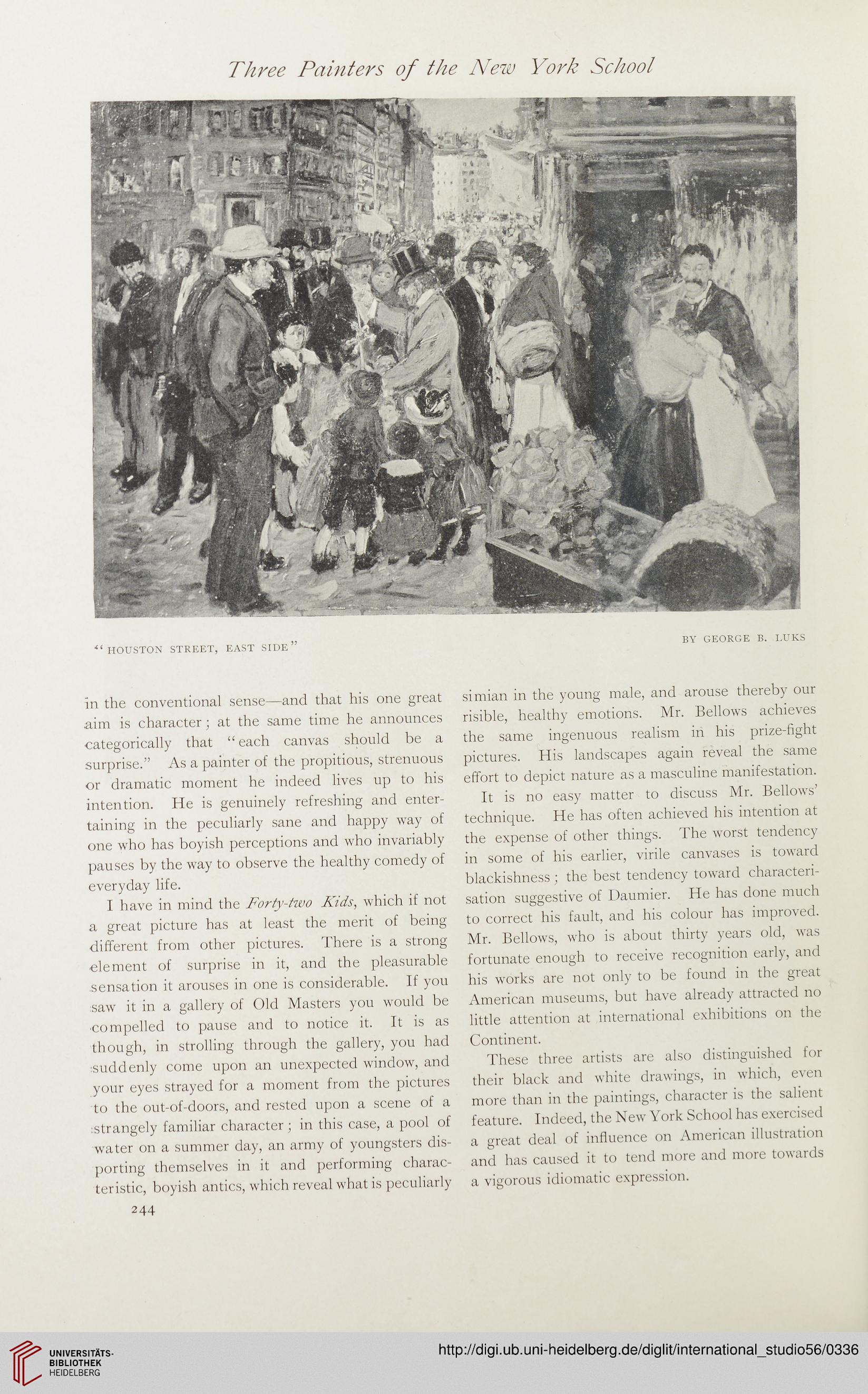Three Painters of the New York School
■“HOUSTON STREET, EAST SIDE”
BY GEORGE B. LUKS
in the conventional sense—and that his one great
aim is character; at the same time he announces
categorically that “ each canvas should be a
surprise.” As a painter of the propitious, strenuous
or dramatic moment he indeed lives up to his
intention. He is genuinely refreshing and enter-
taining in the peculiarly sane and happy way of
one who has boyish perceptions and who invariably
pauses by the way to observe the healthy comedy of
everyday life.
I have in mind the Forty-two Kids, which if not
a great picture has at least the merit of being
different from other pictures. There is a strong
■element of surprise in it, and the pleasurable
sensation it arouses in one is considerable. If you
saw it in a gallery of Old Masters you would be
■compelled to pause and to notice it. It is as
though, in strolling through the gallery, you had
suddenly come upon an unexpected window, and
your eyes strayed for a moment from the pictures
to the out-of-doors, and rested upon a scene of a
strangely familiar character; in this case, a pool of
water on a summer day, an army of youngsters dis-
porting themselves in it and performing charac-
teristic, boyish antics, which reveal what is peculiarly
244
simian in the young male, and arouse thereby our
risible, healthy emotions. Mr. Bellows achieves
the same ingenuous realism in his prize-fight
pictures. His landscapes again reveal the same
effort to depict nature as a masculine manifestation.
It is no easy matter to discuss Mr. Bellows’
technique. He has often achieved his intention at
the expense of other things. The worst tendency
in some of his earlier, virile canvases is toward
blackishness; the best tendency toward characteri-
sation suggestive of Daumier. He has done much
to correct his fault, and his colour has improved.
Mr. Bellows, who is about thirty years old, was
fortunate enough to receive recognition early, and
his works are not only to be found in the great
American museums, but have already attracted no
little attention at international exhibitions on the
Continent.
These three artists are also distinguished for
their black and white drawings, in which, even
more than in the paintings, character is the salient
feature. Indeed, the New York School has exercised
a great deal of influence on American illustration
and has caused it to tend more and more towards
a vigorous idiomatic expression.
■“HOUSTON STREET, EAST SIDE”
BY GEORGE B. LUKS
in the conventional sense—and that his one great
aim is character; at the same time he announces
categorically that “ each canvas should be a
surprise.” As a painter of the propitious, strenuous
or dramatic moment he indeed lives up to his
intention. He is genuinely refreshing and enter-
taining in the peculiarly sane and happy way of
one who has boyish perceptions and who invariably
pauses by the way to observe the healthy comedy of
everyday life.
I have in mind the Forty-two Kids, which if not
a great picture has at least the merit of being
different from other pictures. There is a strong
■element of surprise in it, and the pleasurable
sensation it arouses in one is considerable. If you
saw it in a gallery of Old Masters you would be
■compelled to pause and to notice it. It is as
though, in strolling through the gallery, you had
suddenly come upon an unexpected window, and
your eyes strayed for a moment from the pictures
to the out-of-doors, and rested upon a scene of a
strangely familiar character; in this case, a pool of
water on a summer day, an army of youngsters dis-
porting themselves in it and performing charac-
teristic, boyish antics, which reveal what is peculiarly
244
simian in the young male, and arouse thereby our
risible, healthy emotions. Mr. Bellows achieves
the same ingenuous realism in his prize-fight
pictures. His landscapes again reveal the same
effort to depict nature as a masculine manifestation.
It is no easy matter to discuss Mr. Bellows’
technique. He has often achieved his intention at
the expense of other things. The worst tendency
in some of his earlier, virile canvases is toward
blackishness; the best tendency toward characteri-
sation suggestive of Daumier. He has done much
to correct his fault, and his colour has improved.
Mr. Bellows, who is about thirty years old, was
fortunate enough to receive recognition early, and
his works are not only to be found in the great
American museums, but have already attracted no
little attention at international exhibitions on the
Continent.
These three artists are also distinguished for
their black and white drawings, in which, even
more than in the paintings, character is the salient
feature. Indeed, the New York School has exercised
a great deal of influence on American illustration
and has caused it to tend more and more towards
a vigorous idiomatic expression.




